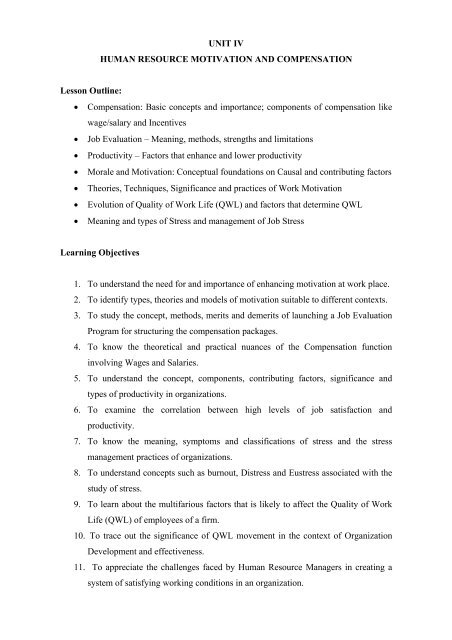UNIT – I Lesson 1 HRM – AN OVERVIEW Lesson Outline Nature of ...
UNIT – I Lesson 1 HRM – AN OVERVIEW Lesson Outline Nature of ...
UNIT – I Lesson 1 HRM – AN OVERVIEW Lesson Outline Nature of ...
You also want an ePaper? Increase the reach of your titles
YUMPU automatically turns print PDFs into web optimized ePapers that Google loves.
<strong>Lesson</strong> <strong>Outline</strong>:<br />
<strong>UNIT</strong> IV<br />
HUM<strong>AN</strong> RESOURCE MOTIVATION <strong>AN</strong>D COMPENSATION<br />
• Compensation: Basic concepts and importance; components <strong>of</strong> compensation like<br />
wage/salary and Incentives<br />
• Job Evaluation <strong>–</strong> Meaning, methods, strengths and limitations<br />
• Productivity <strong>–</strong> Factors that enhance and lower productivity<br />
• Morale and Motivation: Conceptual foundations on Causal and contributing factors<br />
• Theories, Techniques, Significance and practices <strong>of</strong> Work Motivation<br />
• Evolution <strong>of</strong> Quality <strong>of</strong> Work Life (QWL) and factors that determine QWL<br />
• Meaning and types <strong>of</strong> Stress and management <strong>of</strong> Job Stress<br />
Learning Objectives<br />
1. To understand the need for and importance <strong>of</strong> enhancing motivation at work place.<br />
2. To identify types, theories and models <strong>of</strong> motivation suitable to different contexts.<br />
3. To study the concept, methods, merits and demerits <strong>of</strong> launching a Job Evaluation<br />
Program for structuring the compensation packages.<br />
4. To know the theoretical and practical nuances <strong>of</strong> the Compensation function<br />
involving Wages and Salaries.<br />
5. To understand the concept, components, contributing factors, significance and<br />
types <strong>of</strong> productivity in organizations.<br />
6. To examine the correlation between high levels <strong>of</strong> job satisfaction and<br />
productivity.<br />
7. To know the meaning, symptoms and classifications <strong>of</strong> stress and the stress<br />
management practices <strong>of</strong> organizations.<br />
8. To understand concepts such as burnout, Distress and Eustress associated with the<br />
study <strong>of</strong> stress.<br />
9. To learn about the multifarious factors that is likely to affect the Quality <strong>of</strong> Work<br />
Life (QWL) <strong>of</strong> employees <strong>of</strong> a firm.<br />
10. To trace out the significance <strong>of</strong> QWL movement in the context <strong>of</strong> Organization<br />
Development and effectiveness.<br />
11. To appreciate the challenges faced by Human Resource Managers in creating a<br />
system <strong>of</strong> satisfying working conditions in an organization.
















